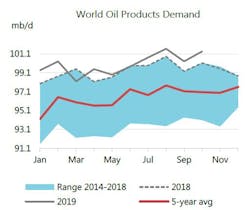In the latest monthly Oil Market Report, the International Energy Agency noted that a global oil oversupply would remain in first half 2020 even if the OPEC+ group adheres strictly to the cut.
For the last several months, IEA has suggested that in early 2020 the oil market is likely to see a significant surplus of supply over demand. On Dec. 6, countries participating in the OPEC+ agreement took a step to address this imbalance by deepening their cuts to 1.7 million b/d from 1.2 million b/d. Saudi Arabia once again showed its willingness to shoulder a greater burden by volunteering an additional reduction of 400,000 b/d to take the total cut to 2.1 million b/d, effective Jan. 1.
Although the voluntary cut by the Saudis has already been partially delivered, the overall effectiveness of the OPEC+ agreement depends on the willingness of all its parties to fully comply, including those whose compliance so far has been less rigorous, IEA said.
“This revised deal excludes from the production ceiling 1.5 million b/d of condensate output by non-OPEC producers. Russia, in particular, now has 800,000 b/d of supply that can legitimately be increased.”
If all the countries comply with their new allocations and Saudi Arabia delivers the rest of its voluntary cut, the fall in production volume versus today will be about 500,000 b/d. Meantime, IEA has reduced its forecast for non-OPEC production growth next year from 2.3 million b/d to 2.1 million b/d, to take account of lower output from participants in the OPEC+ deal and a weaker growth outlook for Brazil, Ghana, and the US.
Even so, with demand outlook unchanged, there could still be a surplus of 700,000 b/d in the market in the first quarter of 2020.
“The market has done its own sums and the reaction to oil’s new deal has so far been muted: Brent crude oil was priced at $63/bbl on the eve of the OPEC+ meetings and as we publish this Report the price is $64/bbl,” IEA said.
Oil fundamentals
Global oil demand increased by 900,000 b/d y-o-y in the third quarter of this year, the strongest annual growth in a year. Nearly three-quarters of the growth occurred in China. Indian demand rose 135,000 b/d, but OECD deliveries fell for the fourth straight quarter and are expected to decline 75,000 b/d overall in 2019.
For 2019 and 2020 IEA have left unchanged its global oil demand growth forecasts at 1 million b/d and 1.2 million b/d, respectively.
Global oil supply held steady in November versus the previous month as higher production from US, Canada, and North Sea offset seasonally lower biofuels output and a substantial reduction by Saudi Arabia. At 101.36 million b/d, production was down 1.2 million b/d year-on-year.
OPEC oil supply in November was 2.69 million b/d lower than a year ago as Saudi Arabia withheld large volumes to rebalance the market and Venezuela and Iran lost a combined 1.4 million b/d mostly due to sanctions.
Non-OPEC production, fueled by the US, was up 1.5 million b/d versus November 2018. Forecast non-OPEC supply growth for 2020 has been revised lower by 200,000 b/d, on a continued slowdown in the US, reduced expectations for Brazil and Ghana, as well as additional cuts by OPEC+. That still leaves supply growth of 2.1 million b/d next year, compared with 1.9 million b/d in 2019.
Expectations for Brazilian output growth for 2020 have been marginally revised following updated production guidance from Petrobras. In its new business plan published in early December, Brazil’s state oil company lowered its production target for 2020 by 100,000 b/d to 2.2 million b/d, reflecting natural production declines in mature fields and maintenance stoppages.
In Ghana, technical problems at Jubilee field and a delay in completing a new well at TEN field led Tullow to sharply cut 2020 guidance, resulting in a 50,000 b/d downgrade to IEA’s overall Ghana forecast. Ghana’s oil production is now forecast to decline by 15,000 b/d in 2020 to 185,000 b/d.
Refining, OECD stocks
The sharp drop in refining margins in November in all markets revealed the delicate balancing act between global crude oil and product markets. Labor strikes in November in several countries were factors in the downward revision to fourth quarter throughput forecast, now expected to be flat y-o-y. In 2020, refining throughput growth is also revised down to 1 million b/d, after a 200,000 b/d decline in 2019.
OECD commercial stocks drew 32.5 million bbl in October to 2.904 billion bbl. They were 2.9 million bbl below the 5-year average and covered 60.6 days, one day below the average. Preliminary data for November showed total inventories falling in all regions, by 23.5 million bbl. Short-term floating storage of crude oil fell 2.1 million bbl in November to 62 million bbl. The number of Iranian VLCCs used for floating storage decreased by one to 26.
US energy independence
In September, the US momentarily became a net oil exporter to the tune of 89,000 b/d. This is a major milestone on its path to becoming a sustained net exporter, which is likely to be late in 2020 or early in 2021. However, this does not mean that energy independence has been achieved, IEA said.
The US remains a major crude oil importer. In September, it received 6.5 million b/d of crude oil, with the largest volume coming from Canada and, with exports of 3.1 million b/d, it remained a significant net importer of 3.4 million b/d.
“Quality issues and greater market competition indicate that US will remain a major crude importer. This exposure to international markets highlights the need to insure against disruptions by maintaining emergency stocks, as reconfirmed in the communique issued at the conclusion of the biannual IEA Ministerial Meeting held last week in Paris,” IEA said.


